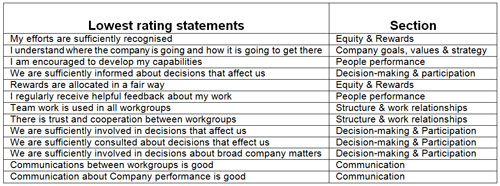2.5.3 What Motivates People At Work?
A few years ago, bpi consultants undertook an employee survey for a company that employed around 100 staff, of whom about 60 worked on the shop floor. Because of the number of Vietnamese employees, we had the equivalent number of survey forms translated into their native tongue.
It was noticeable that the satisfaction levels among the Vietnamese were significantly higher than those white Australians who had been resident here since an early age.
A closer examination of the feedback revealed the reasons for this observation. It was all to do with expectations and where people saw themselves on Maslow’s Hierarchy of Needs.
Maslow identified five levels of need and postulated that it was only after the needs on level 1 were satisfied would that person focus on satisfying those needs on the next level. The five levels are:
- Physiological (food, water)
- Safety (protection, security, stability)
- Social (affection, friendship, acceptance)
- Ego (prestige, success, self-esteem)
- Self-actualisation (self-fulfilment)
For many of the Vietnamese working at this company, their expectations didn’t go far past Level 2 whereas those who had enjoyed Levels 1 and 2 for their whole lives were seeking the satisfaction of needs at Levels 3 and 4.
So what has been happening in recent years of labour shortage and high levels of employment is that employees have higher expectations of how they want to be treated at work. They don’t just want a job that is secure and paid well; they want a job that gives them high levels of job satisfaction – and if their present employer doesn’t provide it, they will be tempted to search for one that will.
So what does motivate people at work who are at Levels 3 & 4 of Maslow’s Hierarchy?
Research in this area goes back to the late 1800’s with the studies of Frederick Taylor, the Father of Scientific Management. Taylor’s focus was on productivity but his experiments showed that productivity was optimised when Level 2 needs were recognised. Good working conditions (at the time, expectations weren’t that high), permitted rest periods and work safety were all taken into account by Taylor in contrast to the Dickensian conditions that were associated with the industrial revolution.
Then in the 1920’s came Elton Mayo and the Hawthorne Experiments which revealed the significance of human relations in organisational behaviour and how productivity could be enhanced if employers sought to satisfy needs at Level 3. Mayo - an Australian by birth incidentally - was followed by the work of Trist and Emery at the Tavistock Institute in the UK who advanced the theory of Socio/Technical systems, and Douglas McGregor in his famous work - The Human Side of Enterprise - published in 1960.
At the same time, in 1959, Frederick Herzberg published his book - The Motivation to Work - where he advanced the notion of “satisfiers” and “motivators” and once again, one can see the connection between these two sets of factors and Maslow’s Hierarchy of Needs. According to Herzberg’s findings, pay, benefits and working conditions do not motivate. They only dissatisfy if inadequate. The Motivators are recognition, achievement and responsibility.
Australian Fred Emery, after working with Eric Trist at the Tavistock Institute for many years, returned to Australia and took up a post at the ANU and refined Herzberg’s concept of motivators and satisfiers. He came up with a list of twelve factors as follows:
Extrinsic Satisfiers - Basic conditions of employment
- Fair and adequate pay
- Job security
- Benefits
- Safety
- Health
- Due Process
Intrinsic Motivators - Conditions for high job satisfaction (and engagement)
- Variety and Challenge
- Headroom for decision-making
- Feedback and learning
- Mutual support and respect
- Wholeness and meaning
- Room to grow and develop
The research of Emery and others demonstrated that these two sets of factors both needed to exist if motivation and job satisfaction were to reach high levels. One set could not compensate for the other.
Furthermore, they also concluded that the first three intrinsic motivators had to be optimised for the individual. I recall a tour of a major manufacturing plant operated by my first employer where we watched one operative making up flat packs of cardboard boxes all day long. I asked him whether he ever got bored doing this for eight hours a day, five days a week. “Oh, no” was the reply, “I make up different sizes!” That was forty years ago - I wonder if they have anyone doing his job today?
Similarly, too much responsibility can cause stress and anxiety.
bpi’s employee feedback surveys are analysed under nine different headings as follows:
- Company goals, values and strategy
- Customer orientation
- Quality and process improvement
- Communication
- Decision-making and participation
- Structure and work relationships
- People performance
- Equity and rewards
- Occupational health, safety and the environment
The key motivational areas are decision-making, communication and some aspects of people performance.
Here are the lowest rating statements for a typical survey.
8 out of the 13 statements fall into the above three categories and one could mount a convincing case that the second statement is also about communication or giving people “wholeness and meaning” in their work.
The feeling of being “in on things” is a particularly powerful motivator and no one has expressed it better than Jan Carlzon, the former president of Scandinavian Airlines in his book “Moments of Truth”.
“There is no better way to sum up my experience than with the story about two stone cutters who were chipping square blocks out of granite. A visitor to the quarry asked what they were doing.
The first stone cutter, looking rather sour, grumbled, “I’m cutting this damned stone into a block”.
The second, who looked pleased with his work, replied proudly, “I’m on the team that’s building a cathedral”.
A worker who can envision the whole cathedral and who has been given the responsibility for constructing his own portion of it is far more satisfied and productive than the worker who sees only the granite before him. A true leader is one who designs the cathedral and then shares the vision that inspires others to build it.”






